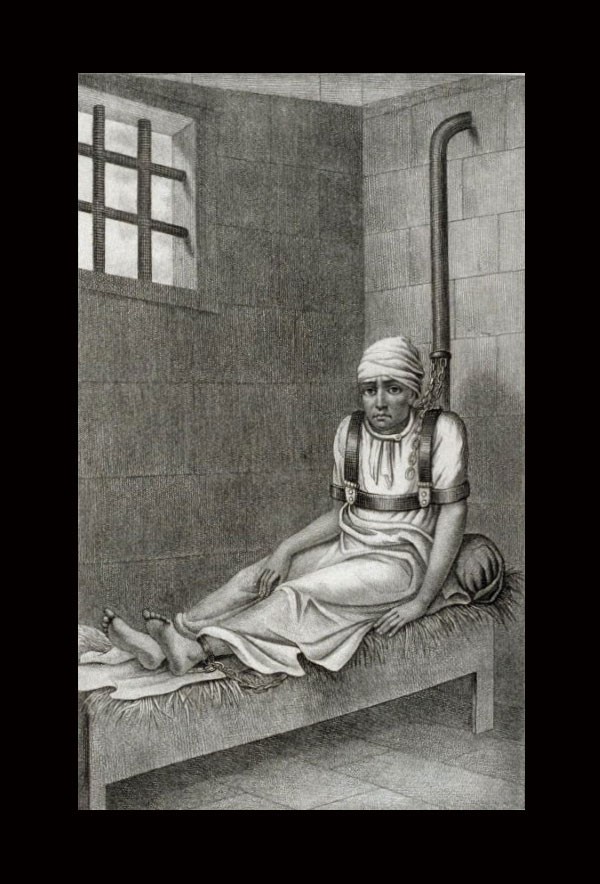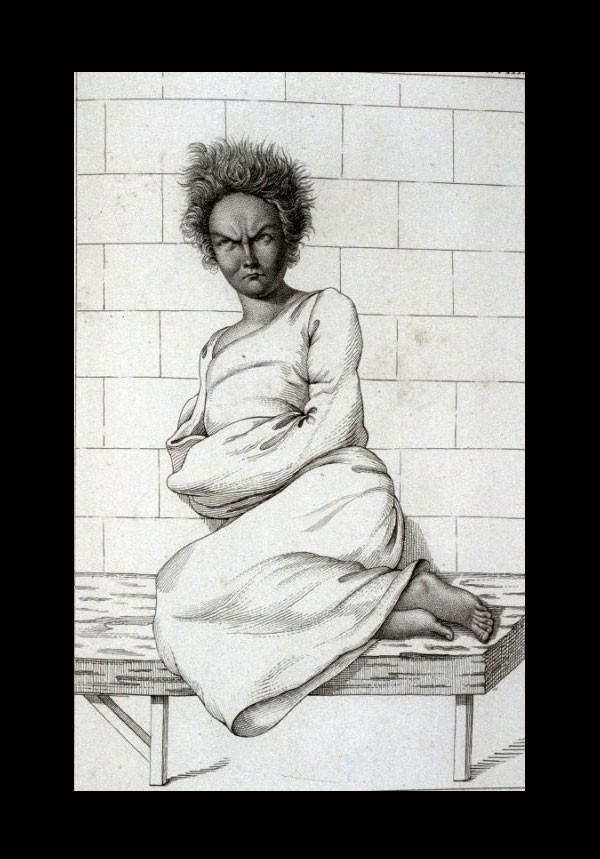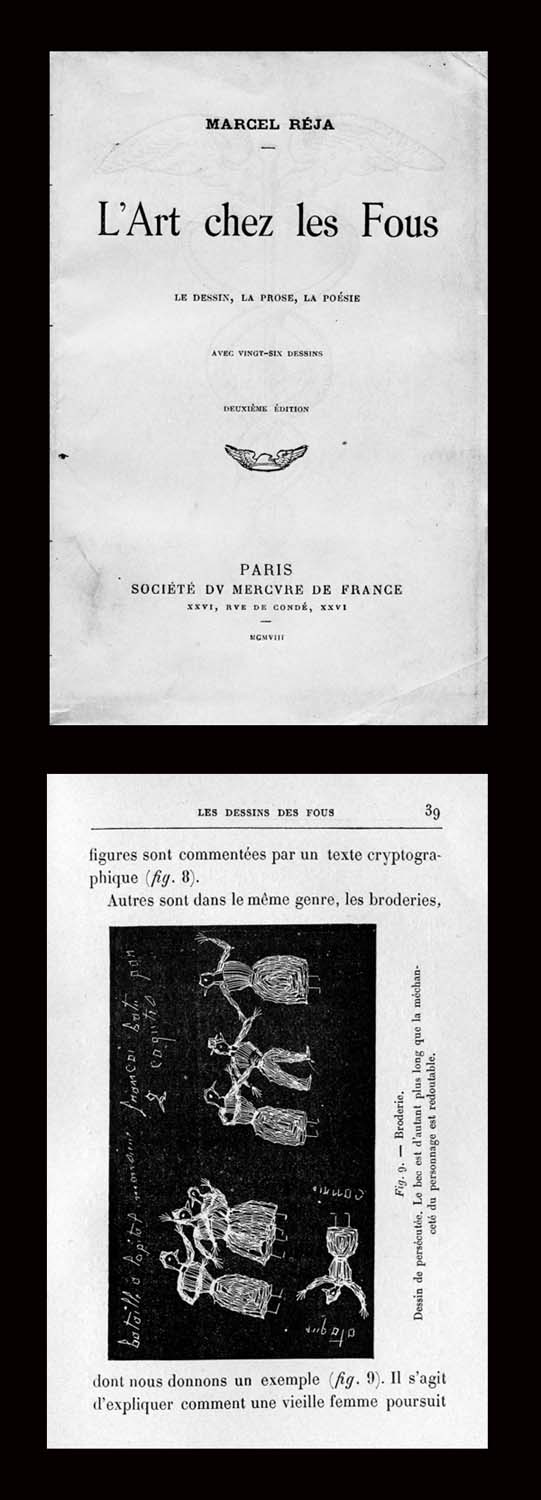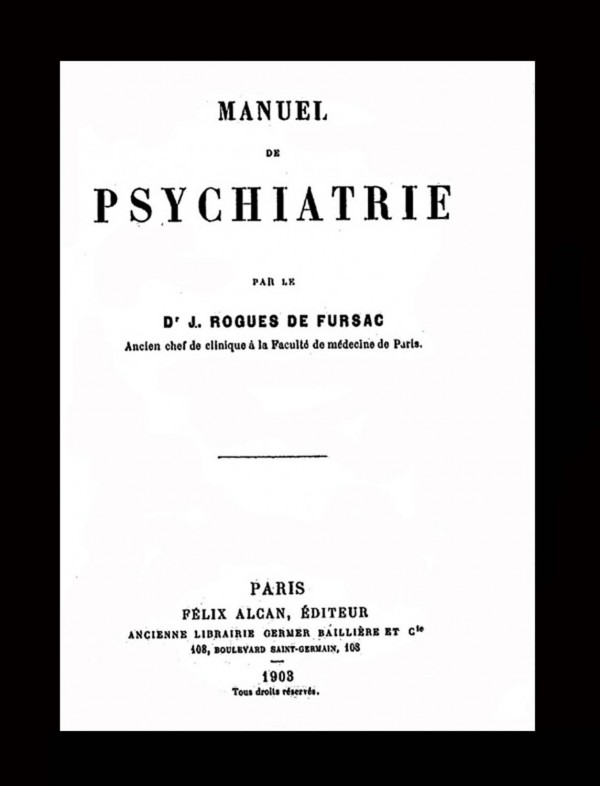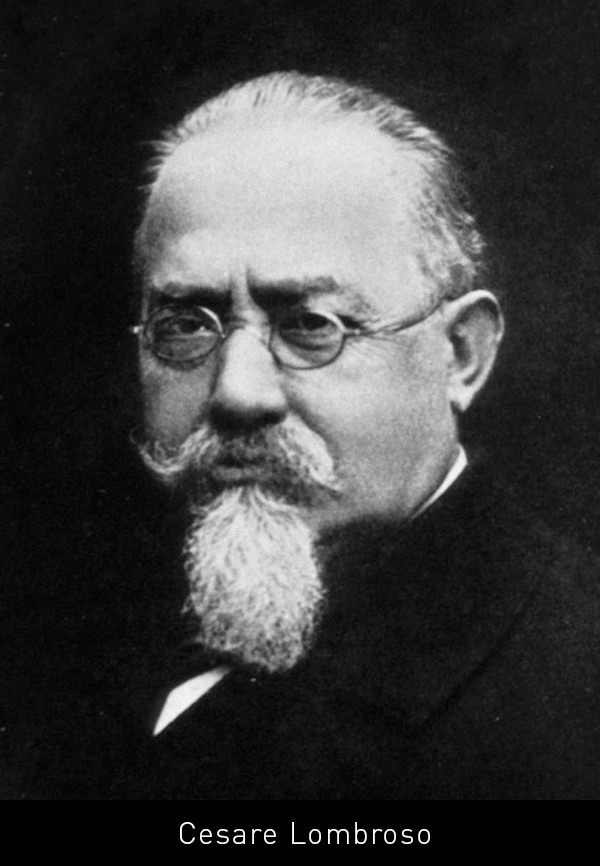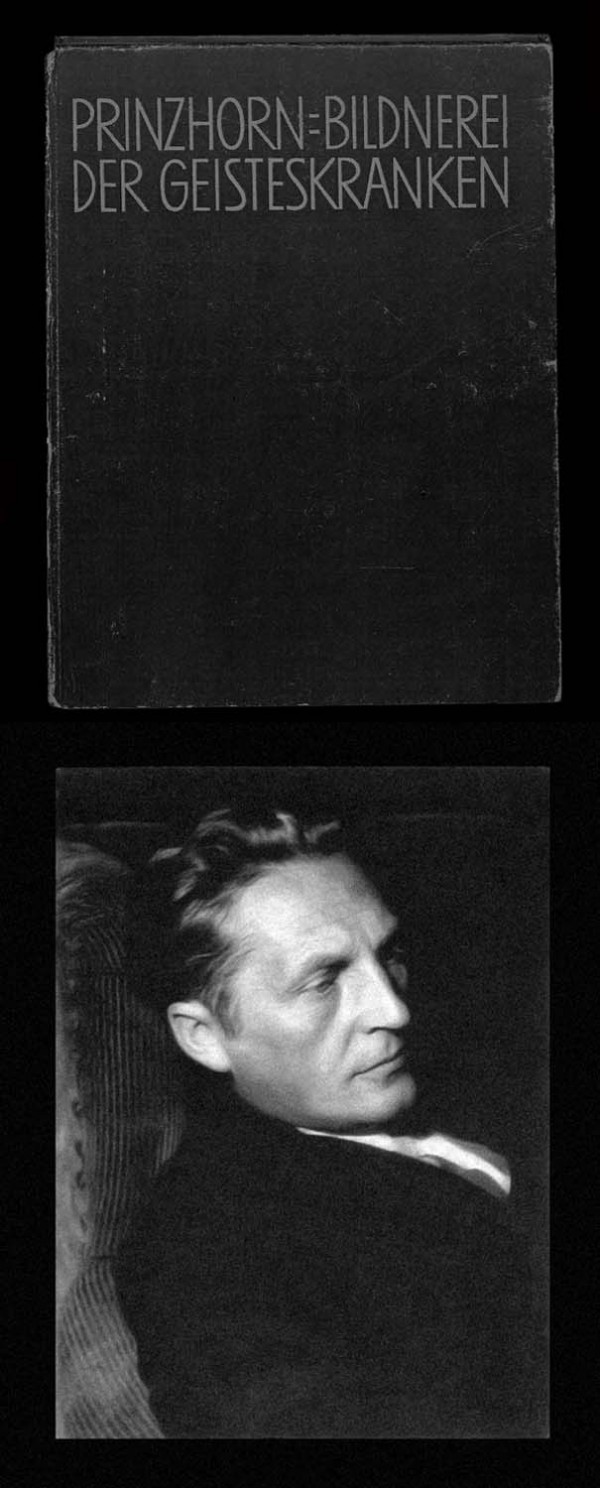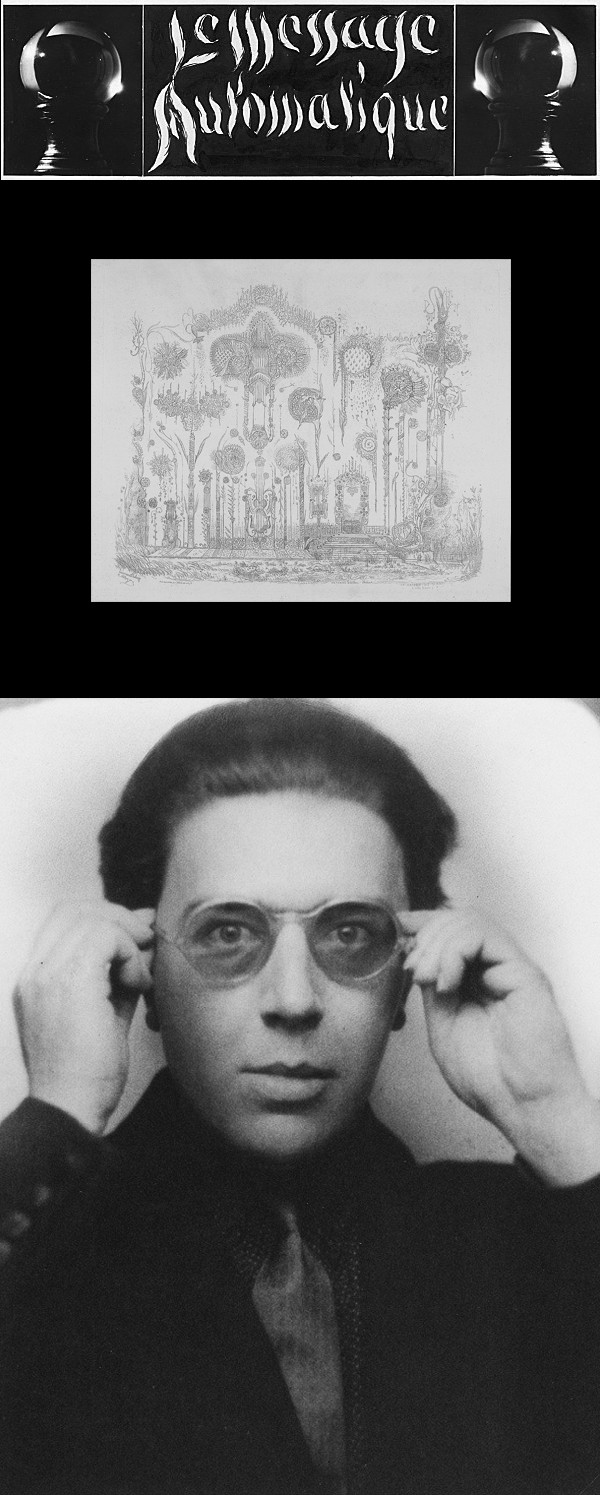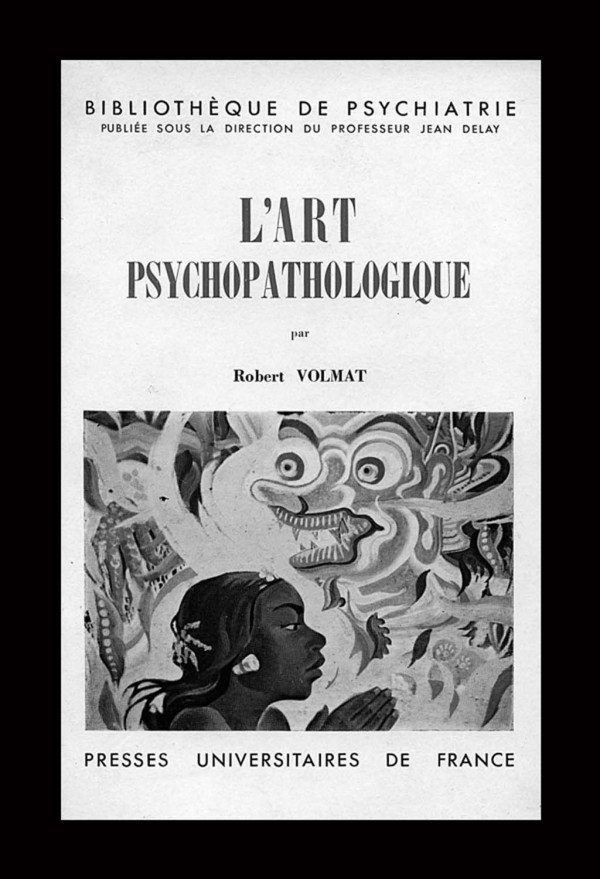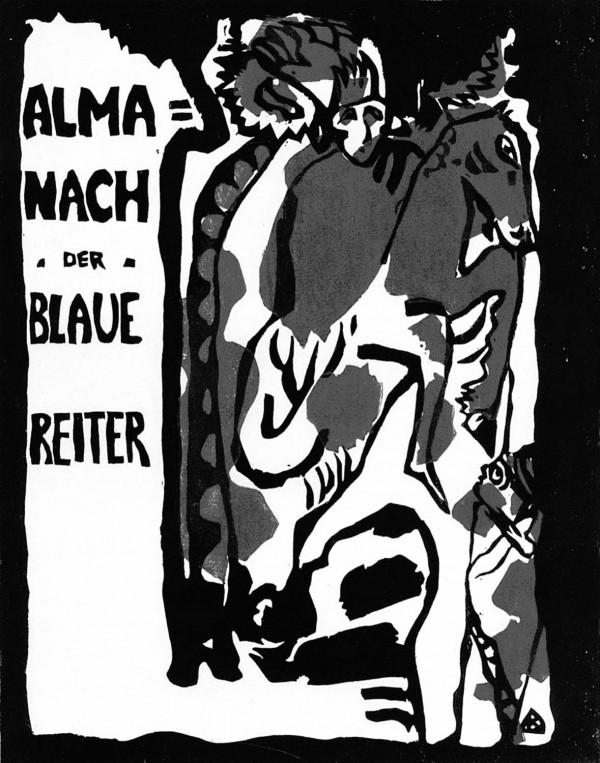The invention of the “art of the insane” from Auguste Marie to André Breton
Enter psychiatrists
The interest in graphic and pictorial creations of the insane is apparent in the works of the French psychiatrists in the last decades of the nineteenth century. One of the earliest is Ambroise Tardieu, who wrote in 1872: “Although we have fixed so far our attention on the writings of the insane, I’m not afraid to say that it is often really interesting to examine their drawings and paintings. Were we to think or imagine the most impossible things, the most bizarre images, we will never succeed in creating the kind of delirium painted on the canvas or by the the hand of the alienated, works that verge on nightmare and make the head spin [1].” There followed the early studies of Max Simon, whose “L’imagination dans la folie : étude sur les dessins, plans, descriptions et costumes des aliénés” [“Imagination in Madness: a Study of the Drawings, Plans, Descriptions and Costumes of the Insane “] appeared in Annales médico-psychologiques in 1876. The contributions devoted to the writings of the patients multiplied in the annals and theses defended by various psychiatrists, Max Simon again in 1888, Jules Séglas in 1892 and Joseph Rogues de Fursac whose Les Écrits et les Dessins dans les maladies nerveuses et mentales [Writings and Drawings in Nervous and Mental Diseases] was published by Masson in 1905.
Based on clinical cases, these works seek first to identify what, in the productions of the insane, may be related to a symptom leading to a diagnosis; second, to establish typologies based on the link between a particular illness and its symptoms. They do not stop at the specific qualities of what remains, in their eyes, a mere medical document. We should not misread the lyrical style of Tardieu: the terms he uses are, at that time and in the cultural context on which he participates, pejorative.The drawings and paintings in question can only produce unpleasant effects, dizziness and nightmares. While the curiosity of these authors makes them examine these new productions, one should not conclude that it would be in admiration. There is no indication that they question the definitions of art and beauty in use. Nor should we lend more artistic intentions to the exhibition held at the Bethlem Royal Hospital in London in 1900 and to the collections started by the doctors, the most often cited in France’s Marie Auguste, who exercised in Paris, then in Villejuif. The word art is used sparingly.
The first showing himself less cautious is the psychiatrist Paul Meunier, known under the pseudonym Marcel Réja. In 1901, in the Revue universelle, he published his first essay, “L’art malade : dessins de fous [2]” [The Sick Art: Drawings of the Insane], which dealt not only with the drawings and which he illustrated basing himself essentially on the collection of Auguste Marrie. Unlike his predecessors, he does not use the psychiatrist’s perspective to seek either symptoms or categories, so much as to affirm, contrary to his colleagues passionate about classifications that “there does not seem to be very close correlation between a kind of madness and a particular art form”. His approach is based on the following premise: “For anyone truly interested in art, such manifestations, disregarding their awkwardness or rudeness, are of great importance by the very conditions in which they have been collected. […] Even if it is poor, the work of the insane is not less important from the standpoint of the genesis of art, its psychological necessity.” “Poor”, “clumsy”, “sick”: those are the words used to describe the creation of the “insane” in this article, therefore we cannot consider Réja as the first to have recognized the artistic qualities of the works from the asylums.
However, unlike his colleagues, he did not look in these productions for the signs of the diseases affecting their authors but wanted to study art in its first rudiments. Clumsiness, in this sense, is not a defect, but a proof that the work studied is indeed to be situated at a very rudimentary stage of creation, so little developed that the origins of art can be observed in its native state. In other words, he includes the “art of the insane” in the history of art and not in the history of madness. This is enough to consider his writings as the new benchmark, both his “L’art malade” of 1901 and, even more his Art chez les fous [Art of the Insane] in 1907. One finds here the same conviction: “Men of genius – even more exceptional, more extraordinary than the insane – show us the tendencies and ways of being of the human mind; the insane reveal them to us in the nakedness of their mechanism with the awkwardness of their ingenuity; we would be certainly less dazzled, but we would be more likely to see clear [3].”
Enter the Primitive
This assertion is inseparable from another statement in 1901: “The history of “art malade” [sick art] is interesting similarly the first artistic stirrings of humanity, trying to engrave on the horns of aurochs or the bones of a reindeer some clumsy images we can find ridiculous, yet whose interest we cannot deny.” In 1907, he develops this suggestion into an entire chapter, Dessins d’enfants et de sauvages [Drawings of Children and Savages]. It opens with the following: “The drawing of the insane is not an absolutely unique genre, an isolated monster among the productions of the rest of humanity. Among the various aspects it presents, some are pastiches of archaic forms of art, others evoke drawings by very special categories of people: prisoners, mediums, children and the savages. This resemblance is often almost complete, so that these neighboring productions elucidate each other, are explained one by the other, and in order to appreciate artistic productions of the insane precisely, it is essential to know their peers[4].“
This sort of comparativism, the assimilations it allows for, the concept même of the “savage” are unacceptable today. They are no less compelling for Réja, who lists the subspecies of the “primitive”: the insane, children, prisoners and the savages. All recall the origins of art in its elementary stage, prior to all education, prior to all history. The subgroup of the “savages” includes two categories: those who are primitive because they lived in ancient times – the prehistoric people – and those who live in remote places – the “indigenous tribes” discovered by explorers and run, in the period in which Réja writes, by colonial empires.
Given the history of psychiatry, this way of thinking was on those days not uncommon. Robert Volmat points this out in his treatise L’Art pathologique [Pathological Art]: “Lombroso (1887-1895) was the first to draw attention to the similarities between the pathological and primitive art [5].” He continues by listing a number of authors, including Réja but also Paul Sollier and his Psychologie de l’idiot et de l’imbécile [Psychology of the Idiot and the Imbecile] (1891) in France and Fritz Mohr in Germany, who initiated several studies of drawings by the mentally ill published from 1906. Meanwhile, the psychiatrist Benjamin Pailhas [6] published in the journal Encéphale in 1908 an a decisive article entitled “De l’art primitif chez l’aliéné” [About he Primitive Art of the Insane]. This doctrine remained widespread in the interwar period, as reported by Robert Volmat while he also notes the objections of rare authors, such as Julius E. Lips [7].
Given the history of artistic creation and, in particular, that of primitivism, these assimilations prefigure what is observed after the First World War: a more and more pronounced curiosity of the Surrealists for “the art of the insane”, which went hand in hand with some publications and exhibitions. We cannot go here into the details of the general history of these primitivisms and the evolution of this vast and composite reference system – evolution itself largely determined by the developing knowledge of archeology, anthropology and ethnography. We will stick to just two – yet essential – points. The first is that the question of the birth of art is at the time frequently debated by anthropologists, such as Ernst Grosse whose French translation of the essay Les Débuts de l’art [The Beginnings of Art] published in 1902, as well as by scientists such as Salomon Reinach and Aby Warburg.
These questions, whose traces can be found in L’Art chez les fous, are stimulated by the succession of discoveries in prehistory, Arts and Crafts movement as well as engravings and wall paintings the age of which was finally unanimously recognized in 1906. The second point is that when Marcel Réja compiles in 1907 his typology of the “primitive”, only one of the categories he mentioned had already penetrated the workshops of contemporary artists: the “savages”, sculptors from Africa and Oceania whom we know have greatly intrigued Derain, Matisse and Picasso in Paris, Kirchner and Pechstein in Dresden and this exactly at the same time [8]. As for children, there will be the studies of Paul Luquet on one hand, on the other the Blaue Reiter Almanac, Kandinsky and Klee. Regarding prehistory, at the beginning of the century it is the domain chosen by only a few painters, sculptors and illustrators, far removed from the Avant-garde [9]. In this sense, artistic primitivisms themselves, far from being an absolute novelty as it was often suggested, can only be understood within the intellectual and scholarly context established from the second half of the nineteenth century. And in this sense yet, while Réja’s comparisons had little foundation and his insinuations were not entirely free from racism [10], the Surrealist discovery of the “insane” owes him nevertheless one of its main stimuli.
Enter Surrealism
This discovery, in Paris, during the interwar period, brings together events that can be separated into two categories; yet they are inseparable and inter-determine each other. On one hand, there are the events initiated by the psychiatrists. On the other, the increasingly insistent signs of interest by poets and Surrealists for the “insane”. The study of the first was launched in the 1980s by the writings of Françoise Levaillant, Marielène Weber and John MacGregor [11], which have not been followed by substantial development since their publication.
It begins in 1921 with the publication of the book that Walter Morgenthaler dedicated to Adolf Wölfli and the book of Hans Prinzhorn, Bildnerei der Geisteskranken, whose first edition appeared in 1922: two books in German, about which it was often believed – probably for this reason – that they were gone unnoticed in Paris. For Prinzhorn at least, this is incorrect. In 1924, in L’Art et la Folie [Art and Madness], short essay of Jean Vinchon, he quotes “the German work of Hanz Prinzhorn” and carefully examines “the watercolors and drawings of ten discordant insane”: “Each of them has his own worldview, rebuilt under the influence of multiple factors: changes in bodily sensations, hallucinations or imaginative musings [12] […].” Vinchon seems to have been particularly marked by the number and quality of illustrations, far superior to those of his own book. The images he uses are however all the more interesting as they prove that he places himself in the continuity of works printed before the First World War. Indeed their legends refer to two collections, Sérieux and Marie. On page 59 there are the photographs of two “sculptures by the insane, in the category of ‘fetish’”: those that Réja published in 1901 and 1907. One of them reappeared six years later, with the caption “statuette (kind of negro art) made by an insane Caucasian.” We can deduce out of this note that the comparativism in the kind of of Réja remained dominant. But the most remarkable is that it illustrates a text whose importance cannot be stressed enough. Published in July 1930 in the Revue du médecin [13], it is entitled “L’art chez les aliénés” [Art of the Insane] and for its author Auguste Marie, “chief doctor of the asylum St. Anne”, this is one of his last publications. It is not an introduction to the question treated as Vinchon did but a retrospective comment sparked by the exhibition of insane artists, held in the gallery of Max Bine, from May 31st to June 16th, 1929 [14].
Marie Auguste was its initiator, as he wrote himself. Not only is this information surprising; it is also the way in which he communicates about it. “My good friend Professor Prinzhorne [sic] from Heidelberg has focused his documentary collections on this [the study of schizophrenia] and his beautiful book is full of evocative drawings of the most incredible imagination. […] He graciously exhibited a number of them the last year in the gallery Bine, where, with Madame la Marquise de Ludre, I could show 300 drawings and documents of this kind [15] […].” Prinzhorn, far from being a stranger in Paris, is thus one of the lenders for this exhibition, which confirms the booklet printed the gallery Bine for the occasion. Even though it is limited and obscure, it nevertheless mentions several collectors, besides Auguste Marie himself: doctors Marchand, Pailhas, Bagenoff and three more familiar names again: Dr. Sérieux, “Vinchon coll.” – meaning Jean Vinchon – and the “Prinzhorn coll.” which lent “symbolic drawings” and “mystical visions”.
Firstly, this is the first big event – three hundred pieces according to Marie – which took place in Paris, well before those, subsequent to the Second World War, which are quoted most often. Secondly, Prinzhorn is one of its architects, not only as a lender, but also as a speaker. Marie says indeed in the last paragraph: “Prinzhorn and myself, in our lectures at the aforementioned exhibition, presented the unexpected confirmations that Freud’s theories can find in the study of certain drawings by the insane. They truly probe into the morbid subconscious. And it is indisputable that it frequently finds erotic orientation [16] […].” Thus in 1930 the most famous collectors of the art of the “insane” and the author of Bildnerei der Geisteskranken publicly place their studies under the sign of psychoanalysis – this at a time when Freud’s critics still dominate the world of psychiatry. Thirdly, despite the homage to Freud, the Exhibition of insane artists is essentially a continuation of the discourse inaugurated by Réja and taken up by Vinchon. This continuity can be recognized in the vocabulary of the booklet presentation. We can read in it: “Sculptures (some of which recall negro art)” and “carved flintstone (Néo Glozel[17])”; the latter term could also fit the collection of false axes made by the asylum patients and collected by Marie, which Réja published in 1901. Marie was also interested, in 1907, in what he described as a “bench carved with many images by means of a piece of glass.” In 1930, the object appears in the Revue du médecin with this note: “Another [patient] engraved bucolic evocation of his former rural life on the back of the bench for agitated inmates with a piece glass coming from the tiles of his destroyed cell”, wrote Auguste Marie, details too specific if he did not preserve the engraved plate himself.
There are other examples mentioned by several authors: the “medals” and the minute allegories by Émile Josome Hodinos that Réja and Vinchon both reproduced, or the so-called drawings of the “funeral”, which were dispersed between pages 35 and 61 of L’Art et la Folie and reappeared in Marie’s study in 1930. A set of visual references comes thus into being through repetition, owing partly their fame to the personality of their owners. A more precise study of the 1929 exhibition would no doubt identify others, but the booklet is so little illustrated and the description so vague that such undertaking is too difficult.
Given these facts, is it necessary to ask again if Prinzhorn was known in Paris and the art of the “insane” available in the interwar period? It is possible that Max Ernst had, as he said [18], brought Prinzhorn’s study as a gift to Paul Éluard when he arrived in Paris. But it is equally likely that the Surrealists had discovered him through Vinchon. If 1924 was the year of the publication of L’Art et la Folie, it was also the date of the First Surrealist Manifesto. We can read in it: “There remains madness, “the madness that one locks up”, as it has aptly been described. […] But their profound indifference to the way in which we judge them, and even to the various punishments meted out to them, allows us to suppose that they derive a great deal of comfort and consolation from their imagination, that they enjoy their madness sufficiently to endure the thought that its validity does not extend beyond themselves. And, indeed, hallucinations, illusions, etc. are not a source of trifling pleasure. […] It is not the fear of madness which will oblige us to leave the flag of imagination furled[19].”
It is possible to go further in the comparative study of Breton and Vinchon. While the definition of Surrealism is based on the concept of automatism, Vinchon begins the conclusion of his essay with the sentence: “Art and Madness meet in the field of psychic automatism [20].” He previously defined it in the terms intended to draw the attention of the Surrealists: “The ecstasies of the mystic delirium and the state of trance of a medium, similar to a dream, can inspire the poet or artist by developing memories from which he draws a surprising result, because it was out of reach during the day. This mode of inspiration is the highest form of automatism [21].” While it is not within the scope of this study to discuss the proximities and differences between the concept of automatism as understood by Vinchon and by the Surrealists, one can not refrain from noting that 1924 was also the date of a text by Robert Desnos, Le Génie sans miroir [Genius without a mirror], which, while presenting “automatic” drawings, unambigously calls for asylum patients. “The Country they discovered was so beautiful that nothing could divert their minds. Diseases! neuroses! Divine means of liberation misunderstood by Christians, you are not heavenly punishment but deliverance, the supreme reward, heaven on earth, vision leading to infinity, the fastest ascent towards the spirit that rises like the vulture with the brains of Prometheus in its beak. […] Let it be known though, it is us who are locked when the door of the asylums close: the prison is around them, the freedom inside. Let’s go to St. Anne! Cells of Salpêtrière[22]!” In respect to the artistic productions mentioned, he concludes: “The pictorial manifestations of the insane are a testimony of fatality. Criticism fades when facing such indisputable works.”
Since then the interest continues to grow. The lettre Lettre aux Médecins-Chefs des Asiles de Fous [Letter to the Heads of the Asylums for the Insane] written by Antonin Artaud is featured in the third delivery of The Surrealist Revolution, published on April 15th, 1925, in homage to the “brilliant quality of certain productions of the insane”. The next issue of the journal opens with the reproduction of a “mediumistic drawing”; the same drawing reappears in 1933 in number 3 of the Minotaur, accompanying the Le Message automatique [Automatic Message], Breton’s essay, which also features Hélène Smith, Augustin Lesage, Count de Tromelin, Victorien Sardou and the Ideal Palace of facteur Cheval. In the table of contents of this issue are also listed Du mur des cavernes au mur d’usine [From the wall of the caves to the factory wall] by Brassaï, Motifs du crime paranoïaque [Reasons of Paranoid Crime] by Jacques Lacan or Le Phénomène de l’extase [The Phenomenon of ecstasy] by Salvador Dali. It is also in the Minotaur, in 1936, that Le Corbusier reveals to the readers “Louis Soutter, l’inconnu de la soixantaine” [Louis Soutter, Unknown in his Sixties], accompanied by his drawings. Other major journals of Surrealism, Documents and Cahiers d’Art, also make a note of it, confirming that the “insane” hold an important place in the Surrealist culture. The exhibition at the gallery Bine in 1929, the conferences of Prinzhorn and Marie and the continued action of the latter as much as that of Vinchon are obviously linked.
As a proof, this is the journey of one work, exemplary of the process of transmission and circulation from one world to another. In 1907, Réja published a reproduction whose legend was “Embroidery. Drawing of a persecuted patient. The length of the beak corresponds to the powerful viciousness of the character.” Astonishing power of expression.”[23] he writes, without specifying neither the author nor the owner. We can decipher the embroidered letters “bataille a lopital monsieur francoi batu par 2 coquines [sic; battle in the hospital mr francoi defeated by 2 minxes]“. Vinchon has not reproduced it. But in 1938, a second embroidery, which belongs to the same series, appeared in one of the major publications of Surrealism, the Dictionnaire abrégé du surréalisme [The Short Dictionary of Surrealism], which accompanied the International Exhibition of Surrealism. Page 71 of the Dictionary, inserted between a painting by Serge Brignoni and a drawing by Matta, presents an “embroidery executed by an insane person”: the same monsters with the face of a bird and long beaks, and the same writing which reads “la coquine tue quatres monsieurs (?), une femme et sont enfant [sic; a minx kills four gents (?), a woman and child are]”. The booklet listing the exhibitors does not say where this embroidery comes from. The question has been resolved since: the embroidery and another one from the same author were found in the collection of Charles Ratton, with the drawings of Hodinos. Ratton was a dealer who was the closest to the Surrealists; he presented the Surrealist Exhibition of Objects in 1936; he acquainted them with Inuit art and reassured them in their passion for Oceania; the connection thus becomes obvious. Did Ratton acquired these pieces at Max Bine? We will never find out, although it is known that there were some “fantastic embroideries and productions by insane women.”
Yet we are certain that these embroideries and drawings by Hodinos had a role in the – very late – discovery of the “art of the insane” by Jean Dubuffet, who transformed it into a chapter of his “art brut”. In Charles Ratton archives there is indeed a letter addressed to him by Dubuffet, dated December 10th, 1944. He thanks the dealer for his hospitality in his country house in Cinqueux, but especially for what Ratton showed Dubuffet that night: “Here we are now rewarded twice, by the great memories and by this black cutch negro sorcerer in the colour of red chalk and licorice that you gave me, which I love and which is so great. The embroideries of the insane and the grandiose compositions of the other insane, were very endearing and I will talk about them to Daniel Wallard because he will start working on the book about the productions by the insane and on which I wil surely collaborate to some extent, however even before having begun this project, I am already confused: should we include the black cutch sorcerer? Is not all Africa mad? The flame which animates and enlightens the human being, is it not the same flame as that of madness [24]?” Fools and Africa? Revoici the comparativism characteristic of the primitivism initially formulated by Réja in 1907.
Thus by the intermediary of Ratton, himself an important cultural and Surrealist movement figure, Dubuffet discovered, at the end of 1944, what the Surrealists exhibited in 1938 in Paris, the art of the “insane” known to them since 1924, if not before, themselves highly indebted to the work undertaken by the German and French psychiatrists in the late nineteenth century. The history of art brut would only begin a little later.
[1] Ambroise Tardieu, Étude médico-légale sur la folie, Paris, J.-B. Baillière et fils, 1872, p. 610.
[2] In the no. 39 and 40, vol. I, p. 913-915 and 940-944.
[3] Marcel Réja, L’Art chez les fous, le dessin, la prose, la poésie, Paris, Mercure de France, 1907, p. 19.
[4] Ibid., p. 63-64.
[5] Robert Volmat, L’Art psychopathologique, Paris, Presses universitaires de France, 1956, p. 197. L’Étude III from which this sentence has been taken out is entitled “Les arts et la pensée archaïques” [The arts and archaic thinking] (p. 196-214) and is a critical history of the comparativism as it could have been accomplished at that date. We consider it as the best synthesis of this issue in the history of psychiatry.
[6] Benjamin Pailhas assembles from this date date a collection bringing together the works of his patients in Albi, at the Bon Sauveur hospital.
[7] Julius E. Lips, The savage hits back, New Haven, Yale University Press, 1937.
[8] A “coincidence” that cannot be held only for such as we must remember that L’Art chez les fous appears the same year in which Picasso works on Demoiselles d’Avignon and Derain or Braque begin to acquire their first “Negro objects.” The precedent of Paul Gauguin is all the more crucial as the artist’s death in 1903 generated several exhibitions in Paris, which revealed the extent of his empathy for the “savages” of the South Seas.
[9] On this point see Philippe Dagen, “Images et légendes de la préhistoire”, in Vénus et Caïn, Figures de la préhistoire, 1830-1930, exh. cat., Paris/Bordeaux, RMN/Musée d’Aquitaine, 2003.
[10]For example, phrases such as: “very backward tribes”, “infancy of the savage”.
[11] Françoise Will-Levaillant, “L’analyse des dessins d’aliénés et de médiums en France avant le surréalisme”, Revue de l’art, no. 50, 1980 ; Marielène Weber, “Prinzhorn, l’homme, la collection, le livre”, in Hans Prinzhorn, Expressions de la folie, Paris, Gallimard, 1984 ; John M. MacGregor, The Discovery of the Art of the Insane, Oxford, Princeton, 1989.
[12] Jean Vinchon, L’Art et la Folie, Paris, Librairie Stock, 1924, p. 72-74.
[13] In no. 10, p. 11-14.
[14] Catalogue des œuvres d’art morbide exposées chez M. Max Bine, Paris, Imprimeries parisiennes réunies, 1929. It is a stapled booklet of sixteen pages, without preface.
[15] Auguste Marie, “L’art chez les aliénés”, Revue du médecin, July 1st, 1930, p. 12.
[16] Ibid., p. 14. Surprisingly, he concludes that these pieces cannot be shown to the “rest of the world”.
[17] “Néo Glozel”, means “in the prehistoric kind”, alluding to the pseudo-discoveries of the site Glozel, an archaeological scandal whose actors went to court and which delighted the press from 1927 to 1932.
[18] Werner Spies, “L’art brut avant 1967”, Revue de l’art, no. 1-2, 1968, p. 125.
[19] André Breton, Œuvres complètes, Paris, Gallimard, coll. « Bibliothèque de la Pléiade », vol. I, p. 312-313.
[20] J. Vinchon, op. cit., p. 119. As soon as 1920, the term “automatism” appears in texts signed by Jean Vinchon together with Maxime Laignel-Laclavetine.
[21] Ibid., p. 64.
[22] Robert Desnos, “Le génie sans miroir”, Les Feuilles libres, January-February 1924. The article was featured under the name of Paul Éluard although Desnos was its author. See Marie-Claire Dumas (dir.), Robert Desnos, Paris, Éditions de l’Herne, coll. « Les Cahiers de l’Herne », 1987, p. 79-97.
[23] M. Réja, op. cit., p. 40.
[24] P. Dagen, “Ratton, objets sauvages”, inCharles Ratton. L’invention des arts « primitifs », exh. cat., Paris, musée du quai Branly/Skira Flammarion, 2013, p. 136. The embroideries and drawings were presented in this exhibition.
